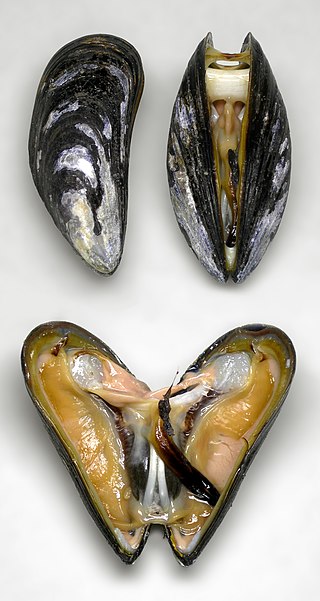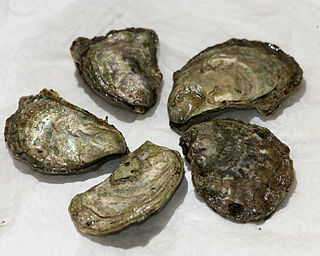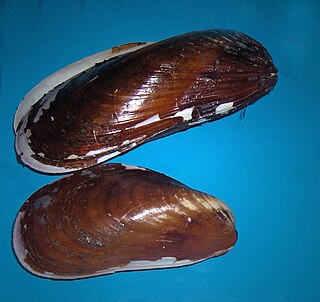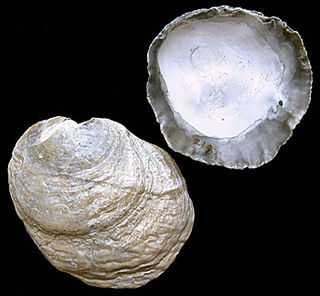
A seashell or sea shell, also known simply as a shell, is a hard, protective outer layer usually created by an animal or organism that lives in the sea. The shell is part of the body of the animal. Empty seashells are often found washed up on beaches by beachcombers. The shells are empty because the animal has died and the soft parts have decomposed or been eaten by another animal.

Bivalvia, in previous centuries referred to as the Lamellibranchiata and Pelecypoda, is a class of marine and freshwater molluscs that have laterally compressed bodies enclosed by a shell consisting of two hinged parts. As a group, bivalves have no head and they lack some usual molluscan organs, like the radula and the odontophore. The class includes the clams, oysters, cockles, mussels, scallops, and numerous other families that live in saltwater, as well as a number of families that live in freshwater. The majority are filter feeders. The gills have evolved into ctenidia, specialised organs for feeding and breathing. Most bivalves bury themselves in sediment, where they are relatively safe from predation. Others lie on the sea floor or attach themselves to rocks or other hard surfaces. Some bivalves, such as the scallops and file shells, can swim. The shipworms bore into wood, clay, or stone and live inside these substances.

The blue mussel, also known as the common mussel, is a medium-sized edible marine bivalve mollusc in the family Mytilidae, the mussels. Blue mussels are subject to commercial use and intensive aquaculture. A species with a large range, empty shells are commonly found on beaches around the world.

Anomiidae is a family of saltwater clams, marine bivalve molluscs related to scallops and oysters, and known as anomiids. It contains seven genera.

Placunidae, also known as windowpane oysters, windowpane shells, and Capiz shells, are a taxonomic family of saltwater clams, marine bivalve mollusks which are related to oysters and scallops.

A bivalve shell is part of the body, the exoskeleton or shell, of a bivalve mollusk. In life, the shell of this class of mollusks is composed of two hinged parts or valves. Bivalves are very common in essentially all aquatic locales, including saltwater, brackish water, and freshwater. The shells of bivalves commonly wash up on beaches and along the edges of lakes, rivers, and streams. Bivalves by definition possess two shells or valves, a "right valve" and a "left valve", that are joined by a ligament. The two valves usually articulate with one another using structures known as "teeth" which are situated along the hinge line. In many bivalve shells, the two valves are symmetrical along the hinge line—when truly symmetrical, such an animal is said to be equivalved; if the valves vary from each other in size or shape, inequivalved. If symmetrical front-to-back, the valves are said to be equilateral, and are otherwise considered inequilateral.

Ostrea lurida, common name the Olympia oyster, after Olympia, Washington in the Puget Sound area, is a species of edible oyster, a marine bivalve mollusk in the family Ostreidae. This species occurs on the northern Pacific coast of North America. Over the years the role of this edible species of oyster has been partly displaced by the cultivation of non-native edible oyster species.

Modiolus modiolus, common name northern horsemussel, is a species of marine bivalve mollusk in the family Mytilidae.

Anomia is a genus of saltwater clams, marine bivalve mollusks in the family Anomiidae. They are commonly known as jingle shells because when a handful of them are shaken they make a jingling sound, though some are also known as saddle oysters.

Isognomon alatus, the flat tree oyster, is a species of bivalve mollusc in the family Isognomonidae. It can be found along the Atlantic coast of North America, ranging from southern Florida to Brazil and Bermuda.

Isognomon radiatus, the radial purse oyster or Lister's tree oyster, is a species of bivalve mollusc in the family Isognomonidae. It can be found along the Atlantic coast of North America, ranging from southern Florida to Brazil and Bermuda.

Pteria colymbus, the Atlantic winged oyster, is a species of bivalve mollusc in the family Pteriidae. It can be found along the Atlantic coast of North America, ranging from North Carolina to Bermuda and Brazil.

Pododesmus patelliformis, the ribbed saddle-oyster, is a species of bivalve mollusc in the family Anomiidae. It is found in the north east Atlantic Ocean.

Corculum cardissa, the heart cockle, is a species of marine bivalve mollusc in the family Cardiidae. It is found in the Indo-Pacific region. It has a symbiotic relationship with dinoflagellates (zooxanthellae), which live within its tissues.

Enigmonia is a genus of saltwater clams, a marine bivalve mollusc in the family Anomiidae, the jingle shells. Enigmonia aenigmatica, the mangrove jingle shell clam, is the only species in this monotypic genus. It is found living on mangroves in the Indo-Pacific Ocean.

Hinge teeth are part of the anatomical structure of the inner surface of a bivalve shell, i.e. the shell of a bivalve mollusk. Bivalves by definition have two valves, which are joined together by a strong and flexible ligament situated on the hinge line at the dorsal edge of the shell. In life, the shell needs to be able to open slightly to allow the foot and siphons to protrude, and then close again, without the valves moving out of alignment with one another. To make this possible, in most cases the two valves are articulated using an arrangement of structures known as hinge teeth. Like the ligament, the hinge teeth are also situated along the hinge line of the shell, in most cases.

A prodissoconch is an embryonic or larval shell which is present in the larva of a bivalve mollusk. The prodissoconch is often but not always smooth, and has no growth lines. It is sometimes still present and visible in the adult shell, if there has been no erosion of the shell in that area.

Pinctada margaritifera, commonly known as the black-lip pearl oyster, is a species of pearl oyster, a saltwater mollusk, a marine bivalve mollusk in the family Pteriidae. This species is common in the Indo-Pacific within tropical coral reefs.

The Anomioidea are a superfamily of marine bivalve molluscs that include two families, the Anomiidae and the Placunidae, the jingle shells and saddle shells. They are mainly sessile bivalves that superficially resemble true oysters. Though they are pleurothetic, however, the Anomioidea attach via their right valve rather than the usual left. Their irregular shells are inequilateral, are round to oval, with a large byssal notch. The byssus itself is usually short and plug-like. The left valve is convex, and the hinge is considered edentulous.

Anomia ephippium is a species of bivalve belonging to the family Anomiidae.

















